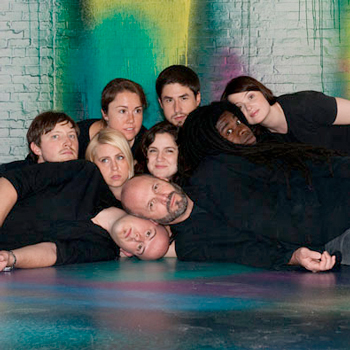by Timothy Robson

Roomful of Teeth carries the human voice to its limits, combining Western classical singing with world music (for example, both Tuvan and Inuit throat singing and yodeling). Aspirates and breathing rhythmically on musical pitches become expressive. Precise molding and morphing of vowel sounds, separately or as masses of sound, create surreal musical images. All of these techniques are directed toward a strong artistic goal. Nothing seems gimmicky, and the performers all appeared to be having a good time. Roomful of Teeth can trace musical forebears as diverse as the works composed by Luciano Berio in the 1960s and ‘70s for mezzo-soprano Cathy Berberian; those anonymous 1950s vocal ensembles who backed up popular singers; and the Swingle Singers.
The first half of the program consisted of a single work: Caroline Shaw’s Partita for 8 voices, its four movements titled as for a Baroque instrumental partita. The relationship of Shaw’s music to its Baroque counterparts is unclear, but was largely irrelevant anyway, given the arresting music that formed each very different movement.
The “Allemande” begins with spoken square dance calls tossed from singer to singer. A characteristic of all of the group’s performances was the instantaneous transition from one method of vocal production to another. Speech becomes song, then vocalizations, vowel sounds, and humming. Later in the movement, text from artist Sol LeWitt’s wall drawing directions is interspersed with the seeming chaos.
“Sarabande” is grounded in a repeated humming pattern in the women’s voices. It then opens to a vowel, then suddenly descends in pitch and becomes a brief, purposeful, audible sigh. Eventually the men belt a fortissimo melody very high in their range. “Courante” is the longest movement, based on an American folk hymn which Shaw uses both whole and dissected into its component phonemes. At times, rhythmic breathing creates the sound of a steam train starting from a dead stop to full steam ahead. Over the “train,” the folk hymn returns ecstatically. “Passacaglia” contrasts sweet and harsh vowel sounds, and a cacophony of speech textures in a series of variations, again with text by Sol LeWitt.
Caroline Shaw’s Partita is a unique and masterful work. It is hard to imagine others performing it, but perhaps they can be challenged to take it up under the tutelage of Roomful of Teeth so that it will have a life beyond its originators.
William Brittelle’s High Done No Why To opened the second half. It is an homage to commercial singing in its harmony and vocal techniques, with the words of the title used for their phonetics, not their meaning. The work ends quietly, with eerie whistling.
Eric Dudley, the tenor in Roomful of Teeth, composed Suonare/to sound in 2010 for the group. Its sound world is magical. The lower voices sing a text by the composer in slow, tonal, chordal style. Simultaneously the two sopranos sing the same text, in Italian, in bel canto style. Their tessitura is very high, and they constantly overlap each other, almost like a tribute to the “Flower Duet” from Leo Delibes’s Lakmé. After all of the other musical sounds we had heard, it was astonishing to hear the two sopranos sing in purely classical style. Both of them have exquisite voices.
Judd Greenstein’s Montmartre is a complex mash-up of many of the techniques we had heard previously. There is no indication of any programmatic component to the work, but it was easy to conjure up the image of a busy Parisian neighborhood, with a mix of pedestrians and taxis and police sirens zooming by.
Although Brad Wells, founder and director of Roomful of Teeth, was not present for this concert, he was represented musically by his quietly ecstatic Render (2013). It is a meditative vocalise, with slowly pulsing lines shifting in and out of focus. Even with all of the virtuosity on display elsewhere in the concert, this was one of the high points.
On a concert of unique music, it might be stretching things to identify a particular work as a “novelty number,” but Rinde Eckert’s enchanting Cesca’s View for women only was in that category, with its picturesque depiction of the Pyrenees and of a yodeling goatherder. Soprano Estelí Gomez’s yodeling was top-notch. Later, soprano Martha Cluver doubled the yodel melody, but in more standard vocal technique, giving a kind of haze to the sound.
The closing number, Judd Greenstein’s AEIOU, is rhythmic and jazzy, with a text consisting only of vowel sounds. Before performing it, Roomful of Teeth gave a well-deserved shout-out to CMA sound engineer Rick Galbraith. Much of the group’s performance depended on well-coordinated amplification. All evening, the sound reinforcement was smooth, seamlessly blending the acoustic bits with sounds that required amplification.
The ensemble returned for an encore, a work with both music and text by Rinde Eckert, I have stopped the clocks. Quiet and improvisatory, with the alto and tenor chant the text on a unison note, but out of sync with each other, the music gradually transforms when others up the text. The piece was full of melancholy.
Trying to describe a performance that draws on so many non-traditional styles can be frustrating. Although the group’s recorded performances can impart a sense of their music, it’s better yet to go to one of their concerts. You won’t be disappointed.
For the record, the singers for this concert were Estelí Gomez and Martha Cluver, sopranos; Caroline Shaw and Virginia Warnken, altos; Eric Dudley, tenor; Avery Griffin, baritone; Thomas McCargar, bass-baritone; and Cameron Beauchamp, bass. For all their individual achievements on Friday evening, the ensemble was much greater than the sum of its parts.
Published on ClevelandClassical.com March 23, 2015.
Click here for a printable copy of this article



